Fred Dimyan, CEO of Potoo – the company that manages multiple online market places, including Amazon – sits down and talks to Ann about how his company works and what it does for consumers day-to-day. It was founded in 2014 to monitor online marketplaces like Amazon and other buying and selling platforms to make sure that the consumer, you, is getting what you’re paying for – and protecting the integrity of brands. To find out more about the company, go to https://potoosolutions.com/.
Author: Harasimowitz, Tracy
Predictive Modeling Class Projects Become Twin Wins for UConn
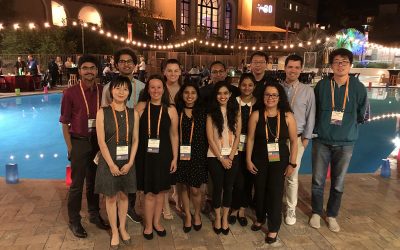
If a pet-adoption agency wants to quickly find a home for a puppy, is it better to post a picture of the pup with its littermates—or a series of photos of the dog alone?And if soccer club owners are trying to identify which FIFA players are underpaid based on their talent, could they accurately do so by analyzing public data about each player’s skill ratings?
Two teams of UConn graduate students used their predictive modeling expertise to successfully answer those questions, and their conclusions led them to tie for first-place in a national, statistical-software competition. Their awards were presented at the JMP Discovery Summit in Tucson, Ariz., last month.
Class Project Turned Into Networking Dream
The predictive analytics project began as an assignment in OPIM Professor Jennifer Eigo‘s classes in Hartford and Stamford last spring. When she learned about the JMP Discovery Summit, she urged students to consider refining their projects over the summer and submitting them to the competition.
The opportunity to attend the conference, which drew some 1,000 people, including top analysts from Exxon, Proctor & Gamble, Apple, Nike, Boeing, GM, Samsung and Abbott Laboratories, was a tremendous networking opportunity for the students, Eigo said. She was impressed to see her students, from the MBA and MSBAPM programs, deeply engaged in discussions with some of the brightest minds in the field.
Pets Are More Adoptable with Individual Photos
Teammates Sherisa Yocher, Saraswathi Sathees, and Rebecca Gill, all MSBAPM students at the Hartford campus, studied pet-adoption rates in Malaysia, where PetFinder.com is the No. 1 animal-welfare platform with a database of more than 150,000 animals. The team analyzed more than 14,500 pet profiles to determine which characteristics led to quick adoptions, defined as 30 days or less.
They examined 14 variables, including breed name, primary color, gender, health, age and more.
Based on their findings, that to expedite adoption, pets should be photographed individually, not in a litter, which seems to confuse potential owners. Ideally, a post should have five to 10 good-quality photos, they found. They also discovered that organizations need to nurse sick pets back to health before putting them up for adoption.
“It was a big undertaking,” said Yocher, who credits well-executed research and an easy-to-follow poster presentation for the team’s success. She also gave credit to Eigo for preparing students to carefully analyze data and select the best model to get results. The team has since shared its results with local shelters, in hopes they can arrange for faster adoptions.
‘The Process Was Fascinating’
The other winning team developed a skills metrics for soccer players in the Federation Internationale de Football Association (FIFA) which is composed of 211 soccer clubs and teams.
Students Vineela Datla, Johana Rodriguez, Anan Garg, and Thore Koch developed a skills metrics for the players, and, based on their attributes created a model to predict their salary range. The students analyzed 88 variables, with special emphasis on position and skill ratings. They also identified a player who they believed was under-valued, Paco Alcacer. He has since received a salary increase.
“It was an amazing experience working on this project with Professor Eigo. The process was really fascinating,” Datla said. “When we started this project, none of us knew anything about FIFA. We researched and learned more about FIFA first before we started working on the project, which really helped us understand the business better.”
The FIFA analytics team is composed of Stamford students, with Datla in MSBAPM and the rest enrolled in the MBA program.
‘The Cherry On Top’
While both UConn teams knew they’d tied for first place, it was several hours before they discovered they would be sharing the honor with each other.
For Datla and Yocher, who were already planning to share a room at the conference, the news was the best of surprises. Both of their teams enjoyed celebrating together.
“To have two of our teams win the top recognition was just the cherry on top,” Eigo said. “It was fantastic. Our students were so proud—and I was proud of them.”
‘Jeopardy!’ Winner Used Analytics to ‘Beat the Game’

Game-show contestant James Holzhauer developed a strategy to quickly maximize the amount of money he won, says OPIM professor David Bergman.
An aggressive strategy, mathematical finesse, a sharp mind, and a willingness to take risks were some of the factors that spurred ‘Jeopardy!’ game-show contestant James Holzhauer to win 32 consecutive games and rake in more than $2.4 million, according to UConn business professor David Bergman.
While some may think it was brainpower and good luck that favored Holzhauer, Bergman says the ‘Jeopardy!’ champ used analytics and strategy to dramatically increase his chance of success.
We need to have more people who can think outside the box. Analytics provides a way to see things beyond conventional thinking.— David Bergman
“As a professor of operations and information management and an analytics expert, I think it is always interesting when people can find new ways to challenge conventional thinking,” he says. “We need to have more people who can think outside the box. Analytics provides a way to see things beyond conventional thinking, creating a new opportunity and a fresh look at traditional strategies.’’
Bergman, who drew media interest for a paper he wrote about how to increase the odds of winning a football pool, has a new paper pending on fantasy sports betting. Sports betting is an industry that is rapidly exploding due to a Supreme Court ruling lifting restrictions on gambling on sports. And, not coincidentally, Holzhauer – the ‘Jeopardy!’ champ – is a professional sports gambler.
Champ Wasn’t Afraid to Take Risks
Unlike other ‘Jeopardy!’ contestants, who worked their way up from the easiest to the most challenging and financially rewarding questions, Holzhauer developed a strategy to quickly maximize the amount of money he won, Bergman says.
He found his success in the higher-value questions, which are harder, but it allowed him to keep control of the board and increased his chances of claiming the Daily Double.
“I’m guessing that if he was confident in a category, he probably hit the buzzer before finalizing the answer in his mind,” Bergman says.
He notes that Holzhauer wasn’t reluctant to risk large sums in an effort to win the game.
“I think his willingness to go ‘all in’ was interesting. He wasn’t scared to gamble $40,000 on one bet, which led to profit maximizing. I think most new players are more timid,” said Bergman, noting that Holzhauer’s educational credentials include a bachelor’s degree in mathematics from the University of Illinois at Urbana-Champaign, a background that likely influenced his decisions.
Holzhauer, who had taken a year off from work to prepare for the game show, had accrued more money than his competitors and was in an advantageous position when he hit a Daily Double. He bet aggressively, and it paid off because he answered 72 of the 76 Daily Doubles he played. Bergman says his technique was far more aggressive than that of Ken Jennings, the previous ‘Jeopardy!’ champion.
The fourth-highest American game-show winner of all time, Holzhauer’s winning streak on ‘Jeopardy!’ extended from April to June 2019 and allowed him to set multiple single-game records for winnings accrued. His winning record intrigued viewers, with one episode drawing more than 14 million people.
Sports Betting Now a $400 Billion Industry
One thing is clear: whether on betting the odds in a game show or in professional sports, there is money to be made, Bergman says.
Last year, the U.S. Supreme Court struck down a 1992 federal law that effectively banned commercial sports betting in most states, thereby allowing the legalization of an estimated $150 billion professional and amateur sports betting industry. Since that ruling, the industry has grown to $400 billion.
“People, like James, are taking advantage of it and placing bets at will,” Bergman says. “Even TV broadcasters are trying to get a piece of the pie. Today you can watch a game on TV and put in a bet before, or even during, the game.”
He says the daily fantasy world is a great business opportunity for betters and platforms, which take 10 percent of the wagers. “Betters with good analytical models can take advantage of this explosion in gaming,” Bergman notes. “A few years ago, I would have been surprised to think of sports and casinos as partners. Today it is having a tremendous impact on the business world.”
Will ‘Jeopardy!’ Ever Be the Same?
But for those seeking armchair entertainment, it is likely that the next big ‘Jeopardy!’ winner will need a new or more refined strategy.
“James destroyed a lot of records, and perhaps changed the game moving forward,’’ Bergman says. “I think it’s possible that in a Tournament of Champions, the people playing against him will need an adversarial strategy. Obviously they will have to take more risks and ‘beat him at his own game’.”
Grad Students Help PCX Aero Go ‘Full Throttle’
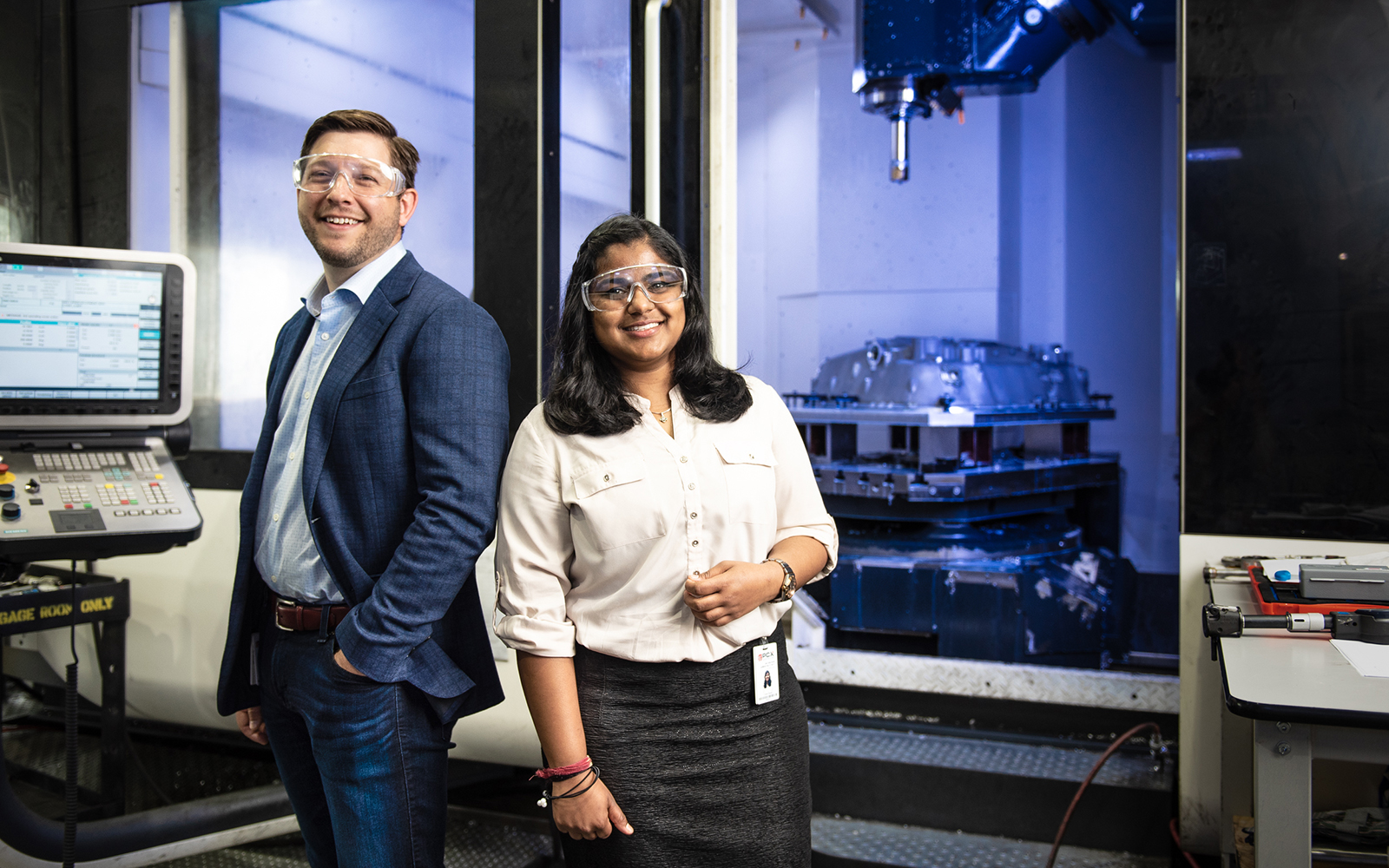
When it comes to the aerospace industry, PCX Aerostructures is in the big leagues.The company is a premier supplier of advanced mechanical systems, specializing in both commercial and military rotorcraft markets, providing highly engineered precision machining of complex parts where tight tolerances and quality are imperative. PCX supplies major customers such as Bell Helicopter, Boeing, Sikorsky and the U.S. Government. It produces flight-critical components to the industry’s highest standards.
When PCX executives reached out to UConn to ask for advice on improving some of their critical data-collection systems—with the goal of developing quicker and more efficient access to data, and reducing expenses—UConn School of Business faculty members were eager to assist.
Six graduate students spent the spring semester helping the aerospace manufacturer strategize improvements in supply-chain management, inventory assessment, and labor-management efficiency.
Aris Fotos, PCX’s general manager and COO, said the assistance has been invaluable.
“In this highly competitive manufacturing sector, we’re always striving for continuous improvement in every facet of our business,” he said. “It’s critical that we seek new opportunities to help position ourselves as an industry leader. This certainly gives us an edge.”
A Proud, Thriving Yankee Company
Few companies can boast of the deep Connecticut roots that PCX Aerostructures can. The company was founded in 1900 by Wilson Fenn as a machine shop specializing in plug and ring gages and ultimately made a brand name for itself through metal-forming machinery. In the 1940s, thanks to a relationship with Sikorsky, the company delved into aerospace.
A community fixture since 1954, the Newington company continues to thrive. PCX doubled its business in the last two years and increased its labor force by 30 percent in the past 18 months. The company’s Connecticut headquarters employs 177, while an additional 63 are based at its sister company in Mansfield, Texas.
PCX also offers integrated special processing services such as heat treating, painting and non-destructive testing. It also possesses large mill-turn capacity and multi-axis gear shaping, in addition to precision gear manufacturing using state-of-the-art machinery.
“PCX is unique in the type of specialized machining and assembly capabilities that we possess. We rely on a skilled workforce to fill the need for Critical Safety Items that are integral, ‘zero failure’ components installed on an aircraft,” said Fotos who earned his MBA at UConn in 2000.
“It’s vital to engage our next generation of manufacturing talent,” Fotos continued. “Reaching out to partners like UConn helps us to leverage the knowledge and ingenuity of students who may be interested in aerospace as a career path.”
The company has invested $16 of new capital equipment in the last five years—a strong selling point for some of the industry’s largest names in aviation, who rely on manufacturers like PCX to embrace the latest technology while minimizing down time and seeking lead-time reductions.
As an industry leader, PCX attracts a wide range of talent, including CNC machinists, manufacturing engineers, programmers and quality inspectors, to name a few. The company attributes its ongoing success to the combined expertise inherent in its workforce.
“This shop is the only one in the world that makes certain parts for certain aircraft,” said Trevor Hartman, vice president of sales and marketing. “We’re a national asset.”
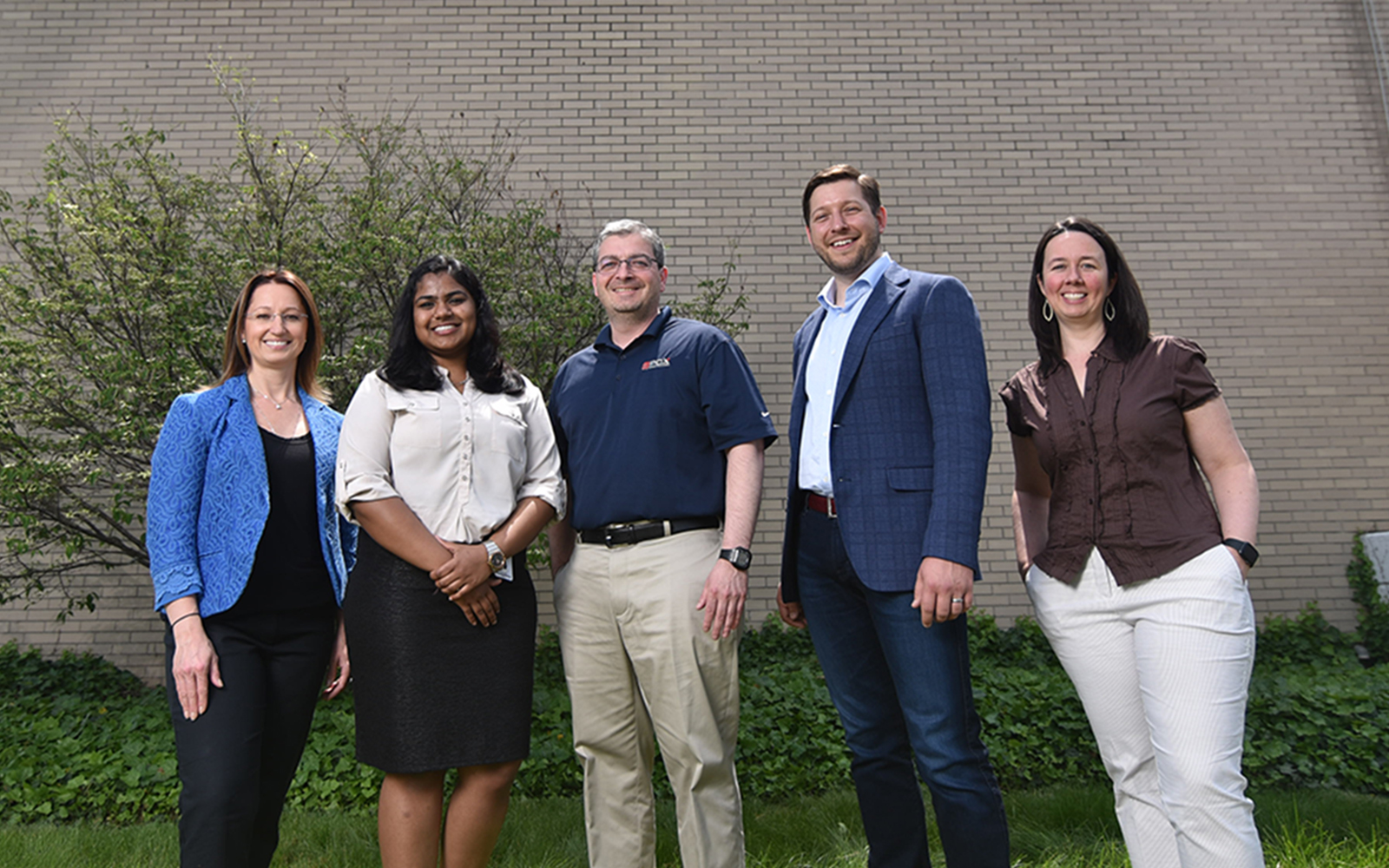
Left to right, professor Anna Radziwillowicz, MSBAPM student Chitra Reddy, PCX general manager and COO Aris Fotos, MBA Student Don Pendagast, and professor Jennifer Eigos. (Nathan Oldham / UConn School of Business)
UConn’s Experts Love Data Challenges
For Professor Jennifer Eigo, who heads the Center for the Advancement of Business Analytics (CABA) at UConn’s School of Business, this project was a perfect opportunity to help a Connecticut company and give students a chance to apply their analytical and project management skills.
“Strategic use of analytics can give a business the information it needs to make data-driven decisions, directly impacting its success,” Eigo said. “UConn is eager to help Connecticut businesses leverage analytics to stay competitive. Manufacturing is a big and important focus in Connecticut.”
“In addition to showcasing their analytics knowledge, our students gain a hands-on experience working with executive leadership,” said Professor Anna Radziwillowicz, who mentored students on the PCX projects. “They also learned more about how the manufacturing industry works and how they can apply value to the business. They gained an understanding of the end-to-end operations of a company in the manufacturing industry, through the lens of executive leaders.”
Students Quickly Immersed Themselves in the Company
Don Pendagast, a UConn MBA student, said the experience will be useful in his career as a management consultant.
“Coming into an organization that I was not at all familiar with, I had to quickly learn about the company, its challenges, and come up with solutions,” he said. “You have to understand the business behind the data.”
Chitra Reddy, a UConn graduate student studying business analytics and project management, described her work on labor-management analysis as phenomenal and exhilarating.
Like Pendagast, she had no manufacturing background. It was particularly rewarding, she said, to know that she contributed to the well-being of the company. As a future business analyst, interacting with the executives, understanding their perspectives on nurturing the business, grasping the data needs and delivering the project “all provided me with a platform to prep myself for setting my foot out in a new professional journey post-graduation,” she said. “I am ever grateful for this amazing opportunity.”
“The students were a very mature group,” Fotos said. “We would receive emails, sent in the wee hours of the night. They truly did a great job. They were determined and able to create something useful for us.”
Two of UConn’s graduate students are currently working at PCX to implement the new plans, and future collaboration between the two organizations is likely.
Now PCX leaders spend a fraction of the time they did in the past gathering data, and can devote more energy to strategic planning and growth, Fotos said.
UConn Takes 3rd Place in Global Analytics Challenge
A team of UConn students earned third place in the 2019 International Big Data & Analytics Education Conference with their passionate presentation on “The Catastrophic Effects of Global Warming—The Forces at Play.”
The team consisted of the graduate students Barbara Lucas Johnson and Prasanthi Lingamallu, and undergrad Carl Johnson. Their adviser was Marketing Professor Girish Punj.
The analytics event is a highly-regarded, worldwide competition aimed at generating innovative analytics solutions while also raising awareness around environmental issues and sustainability. The UConn team used sophisticated data mining tools to chart global warming from 1905 to 2015, identify top drivers of global warming, and recommend initiatives for a healthier planet.
“It is such an important topic that all else is meaningless. Once you start understanding the meaning of all the data, it takes your breath away,” said Lucas Johnson. “When I began this project, I thought I knew a lot about climate change. But after analyzing tons of data and reading hundreds of articles, I realized I knew very little. The climate crisis is really more of a grand challenge, like the fight against cancer. But unlike cancer research, we can all play a role in fighting climate change, each and every one of us.”
Punj said he thinks the students did an exceptional job under challenging circumstances. The project had to be completed in addition to their regular coursework and much of it had to be done over winter break. This is the first time that UConn had entered the competition.
“Much of what’s reported on climate change is factual or based on weather episodes, but the impact is momentary. People are getting ‘climate change fatigue’ and they begin to ignore the impact. Our students used an analytics approach to bring together the facts and connect them with a thread. They were able to relate things like rising sea levels and forest fires. They walked away with something valuable. This is a great example of how science and business can combine to help the world.”
Lingamallu said the team members were all passionate about global warming, climate change and sustainability, and their research fueled their interest.
“We each had very different backgrounds, education, experiences and perspectives on the problem statement, but it is this diversity in thought that helped us put together a very rich and well-rounded presentation,” she said.
Lucas Johnson is a graduate student pursing an advanced certificate in digital marketing strategy; Johnson, her son, is an undergraduate majoring in OPIM, and Lingamallu, a vice president at Bank of America, completed her MSBAPM graduate degree in May. She was also in the Digital Marketing Strategy certificate program.
The students started work in November 2018. They learned in March that they were among the Top 10 teams, and the third-place award was announced June 4 at the conference, sponsored by the University of Maryland in College Park.
“I could never have imagined how much effort it was to find the data, clean it and harmonize it, then try to analyze it,” Lucas Johnson said, adding that the competition and learning to develop important presentations will be instrumental in her career.
She credits OPIM Professor John Wilson for teaching storytelling and visualization and Punj for teaching students about big data, analytics and artificial intelligence.
“The insights and tools from these classes boost any student’s value in the marketplace,” Lucas Johnson said.
CABA News ~ Summer 2019

Sharing Data to Boost Student Retention Rates
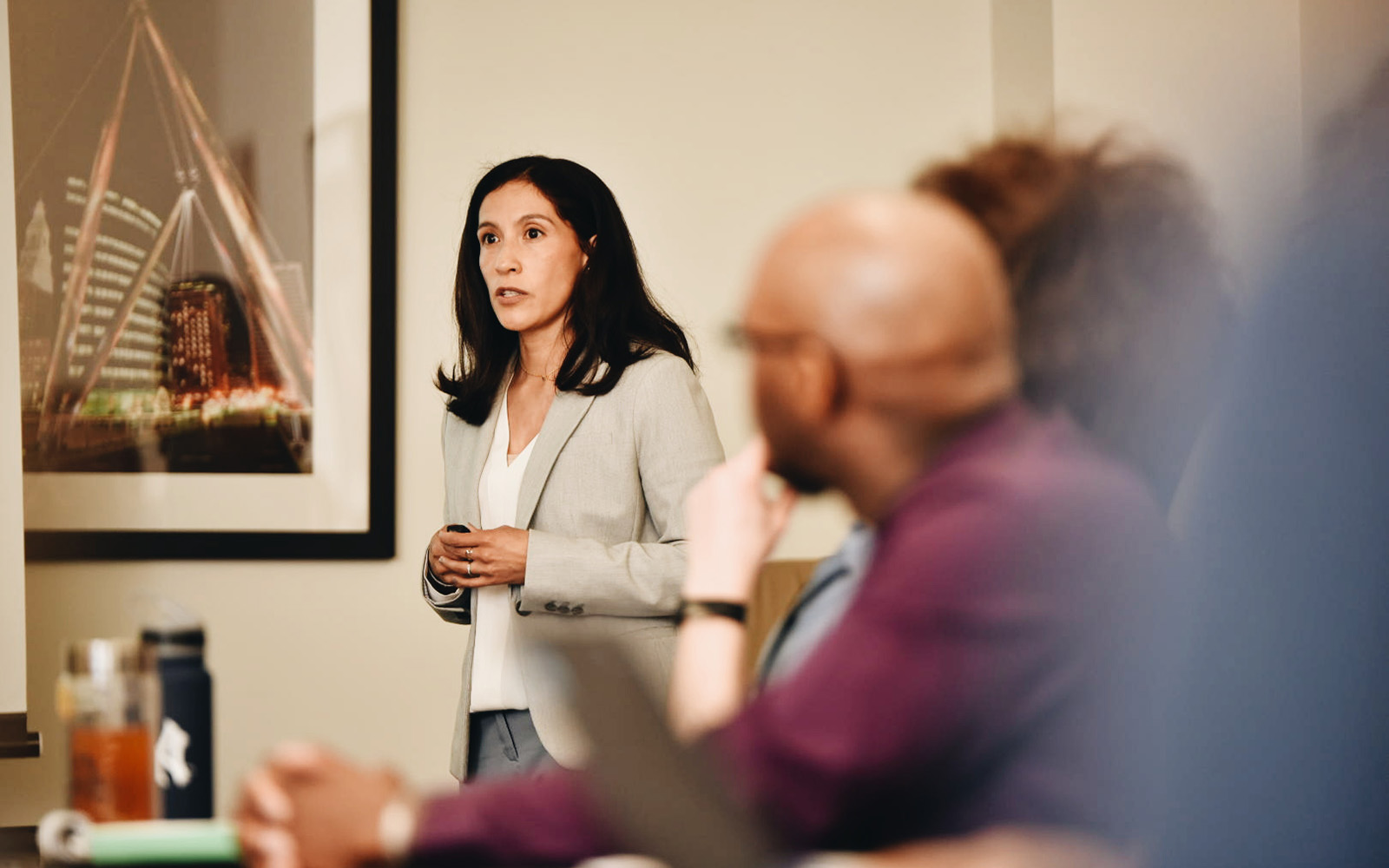
G. Duncan Harris, Interim CEO at Capital Community College, and his team, know the strengths and the struggles that many of their 3,300 students face on the path toward achieving their degrees.But until recently, they didn’t have access to current data analytics analysis to support their beliefs. On April 24, a team of UConn graduate students shared the results of a predictive analytics project, outlining characteristics of CCC students who are most likely to succeed, and those who are at greater risk of dropping out.
The goal in sharing the data is to help CCC boost its fall-to-fall retention rate, which currently hovers around 45 percent. The UConn students’ findings were based on data supplied by CCC, and all student identification remained confidential.
“We hear a lot of stories from individual students, but until now we did not have the aggregate findings from the data analytics,” Harris said.
“The value of this kind of research is immeasurable. We wouldn’t be able to afford to hire a company to do this for us. We are grateful to UConn, our colleagues down the street, for providing this service,” he said. “We are all stakeholders in the success of our community.”
Financial Aid Seems to be Key Factor in Success
The School of Business’ recently created Center for the Advancement of Business Analytics (CABA), connects UConn researchers and students to companies and organizations in Connecticut, and beyond that want to gain insight into their business practices and processes through business analytics. The CCC project was part of that initiative.
Twelve graduate students, all enrolled in UConn’s master’s degree program in Business Analytics and Project Management (MSBAPM), spent about six weeks analyzing five years of data from CCC. They worked under the direction of Professors Jennifer Eigo and David Bergman.
The UConn students found that CCC male students, students who don’t have financial aid, and part-time students were less likely to remain in college. Also, they discovered that the retention rate for majors varied significantly, with nursing having the highest retention rate, at 92 percent.
In addition, the UConn students found that students from non-traditional high schools (whether private, vocational, religious, magnet or home schooled) fared well at Capital. They were surprised that student age and distance of the commute didn’t appear to have a statistically significant impact on success.
The UConn students, in their consulting role, offered a number of suggestions to CCC administrators, such as augmenting the offering of financial advising to students who aren’t eligible for aid, considering more flexible class times for those who are working, studying which advisers work best with specific student populations, and adding additional support for students in the higher-risk categories.
UConn’s Yuly Susaya, who will graduate in May and has accepted a job with Slalom Consulting in Hartford, said she enjoyed gathering, analyzing and presenting the team’s findings.
“I appreciated this project because of the impact we’ll be making at Capital Community College, in Hartford, and in the state of Connecticut,” she said. “I loved working with my team and with this data. It really encompassed all aspects of our BAPM program. They’re our clients and working for them allowed us to put our techniques into practice. They’re doing a lot of great stuff at CCC already, and we hope we were able to offer some guidance as they decide where to direct their efforts now.”
UConn student Sourav Gupta said he enjoyed the project enormously, especially untangling the ‘real world’ data and working toward a solution for an important problem.
“I enjoyed the challenge and knowing it had direct impact,” he said. “Education is very important for people to move up in their lives. We wanted to help the Capital team target those high-risk students and offer them help so they would stay in school.”
Jahydeliss Minano, a business major at CCC, worked as a liaison between the two colleges. Minano, a self-described numbers enthusiast, was instrumental in gathering the data and took on the task in addition to working full-time and attending college.
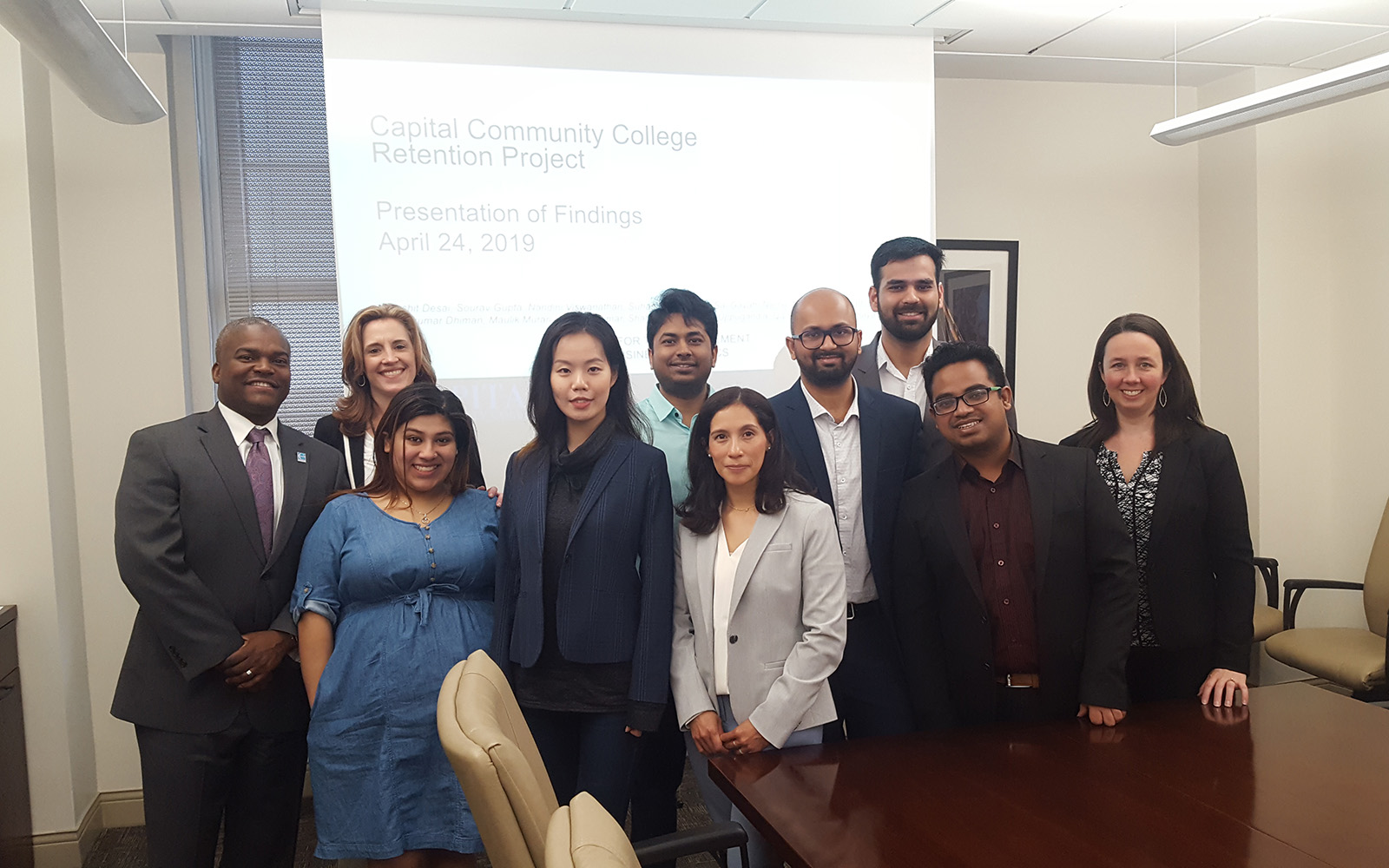
Data Will Be Helpful for CCC Grant Applications
Harris, who was joined at the presentation by other senior administrators and members of CCC’s Strategic Enrollment Management Team, said the information was extremely helpful as the college works on its strategic plan and applies for a new round of federal grants.
“I don’t know if you’re aware of what you’ve given us,” he told the UConn students excitedly. “You have given us a case for greater support. We’ve been focusing efforts on ensuring students maintain their federal financial aid and exploring the impact of employment on student retention.”
Administrators from both colleges are considering extending the partnership. UConn students would like to gather more data, such as how many hours the average student is working, whether marital status impacts retention, how dependents influence completion of college, and the most common reasons students leave CCC.
“This partnership is phenomenal,” said Miah LaPierre-Dreger, CCC’s Interim Dean of Academic Affairs. “A lot of community colleges across the country would love to have this kind of data about their programs.”
“I think our students were really inspired by the idea of working collaboratively with Capital Community College,” said Eigo, who is also the associate director of CABA. “Whereas much of the business world is about the bottom line and financial success, this project was about using analytics skills to make a difference in people’s lives, specifically by identifying the factors that are important to keeping students enrolled as they work towards their degree.”
Harris praised the team effort and said the information and collaboration was good for students, for Greater Hartford, and for the state.
“You’ve affirmed that we’re on the right track with the recent student-success strategies we’ve deployed and provided a data-informed platform for the launching of others,” he said. “The spirit of collegiality and support for our shared community exhibited in this project was phenomenal.”
UConn Graduate Students Present to Capital Community College in Hartford

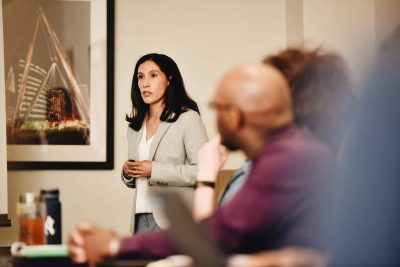
UConn Graduate Students Present to Capital Community College in Hartford
Jose Cruz to Receive Service Excellence Award
Posted on March 26, 2019 by Claire Hall

Jose Cruz of the UConn School of Business will be presented with the Service Excellence Award from the American Association of University Professors in April. (Nathan Oldham / UConn School of Business)
For his outstanding work with the MSBAPM program and other initiatives, OPIM associate professor Jose Cruz will be awarded the Service Excellence Award from the UConn chapter of the American Association of University Professors (AAUP).
Cruz, the academic director of the MSBAPM program, is one of 10 UConn professors who will be honored at an award ceremony from 9 to 10:30 a.m. April 15 at the State Capitol building in Room 310. All are welcome to attend. Please RSVP to BarbaraK@UConnAAUP.org or call 860-487-0450. The awards are designed to showcase academic excellence at UConn.
“Prof. Cruz has always gone above and beyond his service expectations. He does these things happily, spontaneously and without expectation of reward or recognition,” said Professor Suresh Nair, OPIM interim department head. “For these reasons he is among the most popular faculty members I have met–among his peers, his staff, and the students in the program he manages.
“Professor Cruz is self-effacing and modest, yet persistent and has the conviction of ideas and the drive and energy to get things done. That is what makes him succeed spectacularly in his service endeavors. Under his direction the master’s in Business Analytics and Project Management (MSBAPM) program has grown from about 50 students to 500 currently and is among the Top 20 such programs in the country. His use of assessment of learning surveys ensures he keeps improving program content and delivery.”
OPIM professor David Bergman said he cannot think of a more deserving colleague and that Cruz brings a tireless devotion and positive impact to the University.
“The discipline of business analytics is changing at a rapid pace and Jose works hard to ensure that the MSBAPM program remains at the cutting edge,” he wrote in his nomination. “It is easy for an academic degree program to become stale if faculty aren’t working hard to improve upon the course offerings. Jose is always challenging the norm. He asks each of the faculty to improve on their course offerings. This translates to high-quality graduates, enhancing the reputation of the program—and UConn as a whole.”
Bergman went on to say that as a new faculty member, Cruz immediately reached out with a sincere offer to help in any way possible. Bergman said he frequently turns to Cruz for advice and ideas about professional growth.
Professor James Marsden, former OPIM department head, said that when the MSBAPM program was created, it was so groundbreaking there were no others to model it from.
“Jose’s efforts involved innovation and creative thinking,” Marsden said. “His insights helped lead MSBAPM to success in terms of high enrollments, high external rankings and overall recognition.”
He also noted Cruz helped in leading the development of the new Center for the Advancement of Business Analytics (CABA) which attracted three founding partners including Stanley Black & Decker, UTC and LIMRA.
“Cruz has delivered on a level that shines brightly on our department, our school, our university and our state,” Marsden said. “I admire all that he has accomplished and am honored to have him as a colleague.”
His teaching interests are in operations management, research, business analytics and project management. His research is multidisciplinary and combines his background and interests in management, engineering, computer systems and applied mathematics. He has received the School of Business Ackerman Scholarship Award twice, Outstanding Graduate Teaching Award, Outstanding Undergraduate teaching Award and the Distinguished Service Award. He teaches MBA, EMBA and undergraduate courses.
CABA Shifts into High Gear
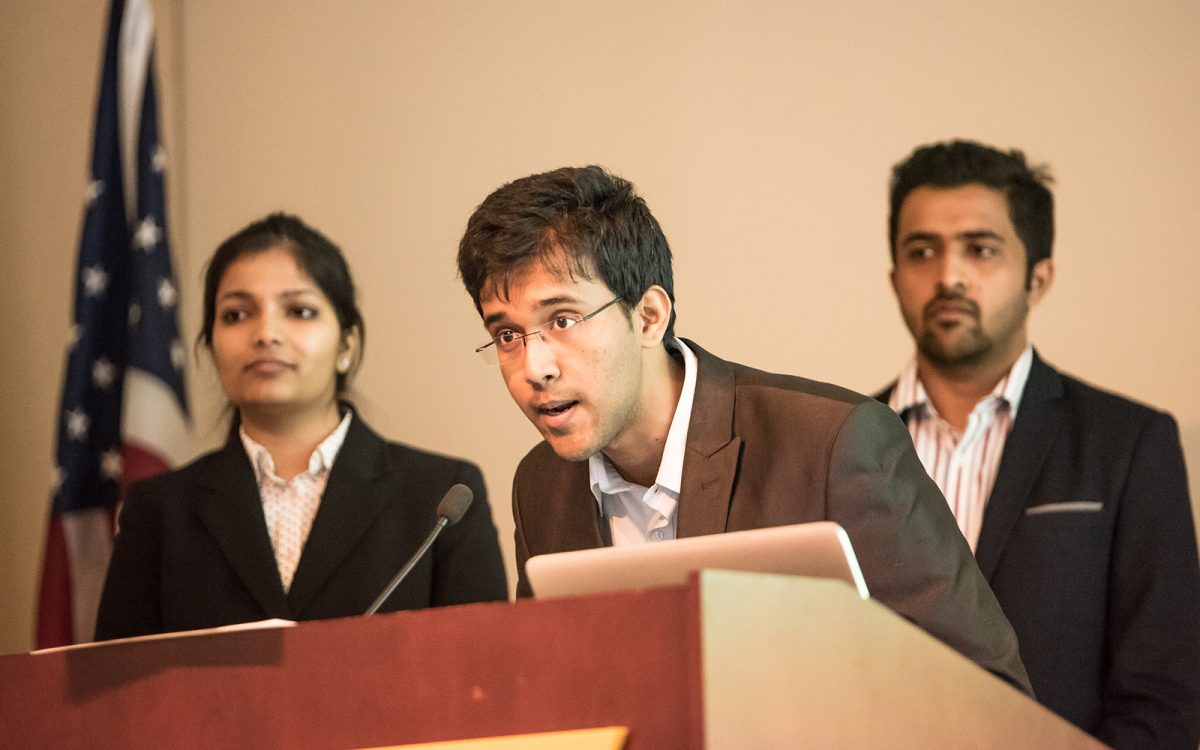
UConn MSBAPM Students Help Stanley Black & Decker ‘Nail Down’ Its Data Analytics Info
Stanley Black & Decker executives wanted to optimize their vast repository of data from their Healthcare division, but were hampered because reports came from four different information systems.
If they were able to capture more unified and robust data, they could identify spending patterns that would allow them to redeploy inefficiencies and foster growth initiatives.
Recognizing that the process had become too cumbersome, Joe Radziewicz, vice president of internal audit, Doug Dentler, Stanley Healthcare CFO, and other Stanley executives, turned to UConn graduate students for help.
They presented them with a challenge: create a new dashboard—one that is fast, efficient and easy to use, and will allow managers to analyze information and track potential cost savings. More than 80 students, all studying for a master’s degree in business analytics and project management, took on the challenge.
“The UConn students showed great mastery in data analytics and a passion for that science. They were curious, excited and thought ‘outside the box,’” Radziewicz said.
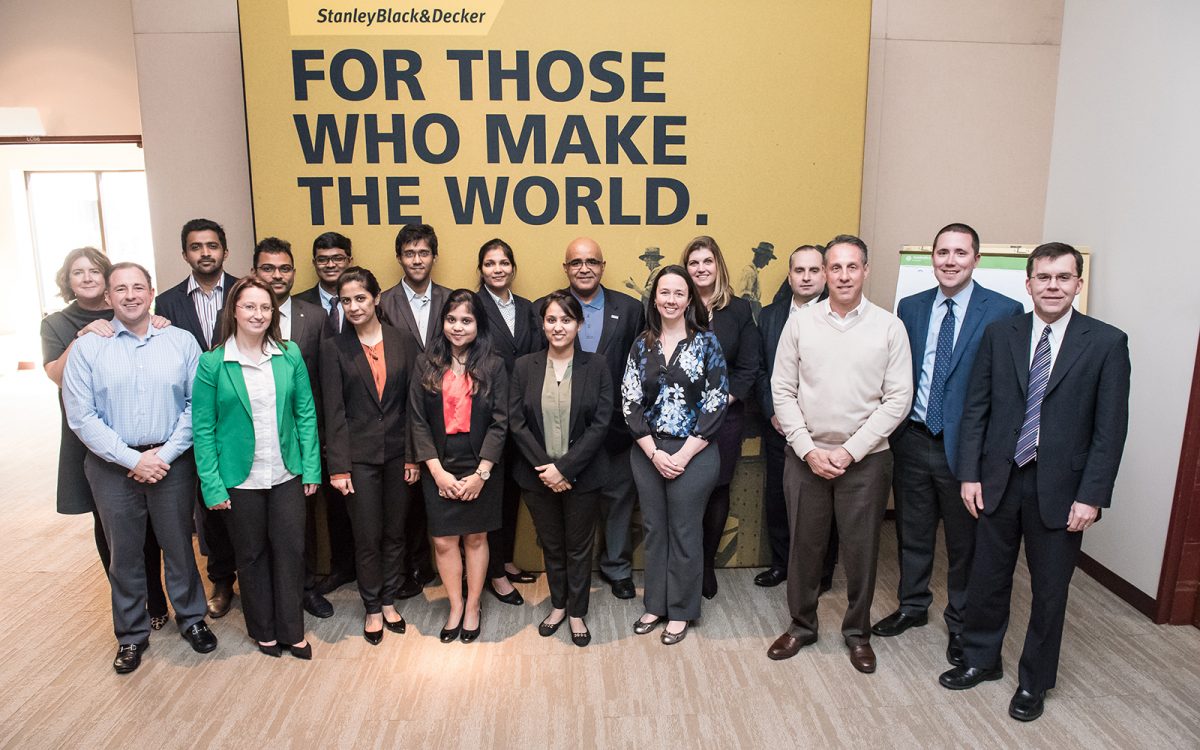
“We were able to leverage the UConn students’ expertise to develop a visualization technology to capture important data and the types of expenses that we are incurring, and to analyze trends. Our ultimate goal is to eliminate wasteful spending,” he said. That savings can be reinvested into innovation for customers, digital technologies and other growth initiatives, he said.
The project began in December and is now in the final stages. Stanley Black & Decker is working with the students to take the best of all the ideas and incorporate them into a final platform.
In the case challenge, the team of Sravanthi Kappuram and Sarath Mandava took first place and a $1,000 prize. Second place, and a $600 award, was given to Ravi Gurram, Aditi Aditi and Shweta Ikhe. The third-place team, recipients of a $400 prize, included members Suhas Nadiga, Karpagam Vinayagam, and Anoop Ramathirtha.
“The final teams were chosen based on their ability to drill down and obtain data in different ways. We also looked for user-friendly approaches to data collection,” Radziewicz said.
CABA Fulfilling Its Mission to Advance Education, Business
This is among the first big projects for the School of Business’ new Center for the Advancement of Business Analytics (CABA), which is designed to be a hub for business analytics and data science, serving both educational and business needs. Professor John Wilson is the center director.
“We are one of the pioneers in graduate-level education in analytics,” said Ram Gopal, department head for Operations and Information Management (OPIM), noting that some 400 students are enrolled in the UConn program in Hartford and Stamford.
“We were one of the early programs in the U.S., and have developed a very strong reputation. Our curriculum is at the cutting edge, and we are constantly revamping it to bring state-of-the-art techniques. We engage well with our corporate partners with capstone projects and data challenges. The Stanley Black & Decker competition is a great reflection of that.”
“Analytics experts are among the most in-demand in the country and it is a field that will continue to grow into the foreseeable future,” Gopal said. “Data-based decision making is developing deep roots. We prepare students to be well-equipped with analytics and big data assessment.”
LIMRA, a 100-year-old trade organization serving the life insurance and financial services fields, was the original CABA partner. Robert Kerzner, LIMRA’s CEO, said he sees a growing importance for businesses to leverage their analytics and data science capacity.
“Working with the University of Connecticut, we hope to help our members advance their individual data analytics initiatives, as well as develop projects that could benefit the industry as a whole,” he said. Other partners include Tableau software and Stanley Black & Decker.
For Students: Real Company, Real Impact
“It is so exciting that with CABA we are able to bring these real-world business projects to our students where they can gain valuable experience putting their analytics skills into practice,” said Professor Jennifer Eigo. “And the data visualizations from the winning teams will have an immediate impact for Stanley Black & Decker.”
For Mandava, the project boosted his confidence as he seeks employment. “I will always remember the reaction of the clearly impressed judges during our presentation,” he said. “With the reaction we got, it is safe to say our dashboard had a real impact!”
Gurram, who devoted 150 hours to the challenge, said overcoming Stanley’s data project allowed him to accomplish more than ever before, including learning how to look at a project through the eyes of future dashboard users.
“Doing a project for a real company, with real impact, will be a great selling point for me moving forward,” he said.
Kappuram said the initial stages were very difficult, especially trying to understand the data, addressing some parameters and making sure the plan was complete. “I’ve talked about my experience and challenges in several interviews, and I’m sure it will stand out as one of my significant technical achievements,” she said.
Radziewicz, from Stanley Black & Decker, said the company is humbled to have been able to partner with such expertise.
“In business, there is tight competition for students who have this new skill set,” Radziewicz said. “We’re fortunate to have a great resource in Connecticut that we can leverage.”
“For UConn, the students, and Stanley Black & Decker, this is a win-win-win,” he said. “The students get experience with and exposure to a Fortune 500 company, the University’s curriculum is supplemented with real-life business cases and data sets, and Stanley gets access to a great talent pipeline and support for projects that benefit our community.”
